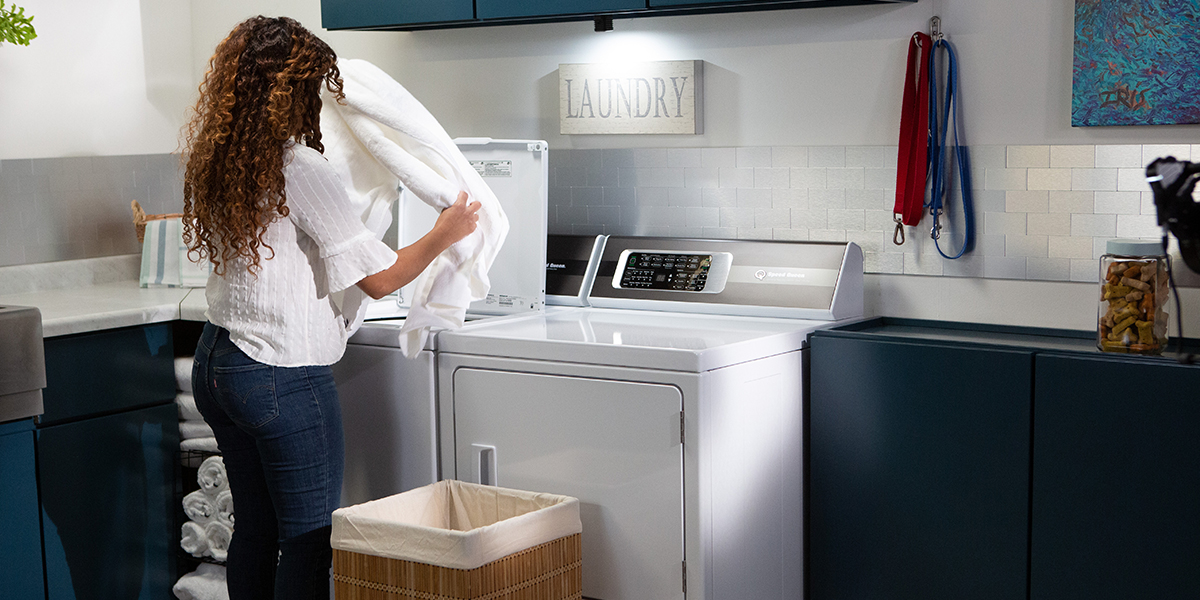Is your washing machine staining clothes? It might be. If you wash your clothes with detergent and notice weird stains that were never there before, you might be dealing with detergent stains or perhaps even oil, limescale, and rust stains. After a wash, this is usually the last thing you expect, but it’s more common than you might think. However, there’s good news—there are ways you can both prevent and clean these mystery stains.
Detergent stains on clothes
If you’re ending up with white or blue stains on clothes after a wash, you’re probably dealing with laundry detergent or fabric softener not dissolving during the wash and creating stains. This can happen if you’re using the wrong type of detergent for your washing machine or using too much detergent or fabric softener than your washing machine is designed to use. If it’s not releasing detergent the correct way, it can quickly spill into the wash and cause potential stains. That’s why we recommend using 1-2 Tablespoons of HE detergent and putting it directly into the washing machine tub to avoid these situations. While we may not recommend the use of fabric softener, you can still add it by using the fabric softener dispenser. If using the Normal/ECO cycle, ensure the Extra Rinse option is selected or you may notice staining. Or, use white distilled vinegar instead, since there would be no risk of staining.
These types of post-washing stains are primarily due to excessive amounts of detergent leaving behind a residue, which in turn can trap additional dirt particles and lint. Simply put, more detergent isn’t better—we recommend 1-2 Tablespoons of HE detergent. Overloading your washing machine can also cause staining problems as well due to the machine not being able to properly circulate water and detergent.
Laundry detergent stains are obviously the exact opposite of what you want to happen after a wash, but there are solutions to help remove the stains and keep them from happening in the future.
How to get laundry detergent stains out of clothes
So you have a post-wash stain caused by detergent? No problem. First, check your clothing’s care label to see if there are any special instructions related to the fabric.
Otherwise, there are a variety of products that can be used to help remove detergent stains. But, we recommend spot testing an invisible corner of your clothes to see how each treatment reacts with your garment’s materials.
First, soak the stained clothing item(s) in warm water and let it sit. This might do the trick and lift the stain by itself. If not, then it’s worth moving to rubbing alcohol, vinegar, and baking soda. Again, check your clothing’s care label for instructions, then test these materials in an inconspicuous space on the clothing. These household materials aren’t as tough on clothing as other products, so it’s worth an attempt to see if they’ll do the job. Give it some elbow grease and some time before giving up.
If these don’t work, then it’s time to move on to using an oxygen-based pretreatment (such as oxygen bleach). Soak the clothes in warm water, then apply an oxygen-based pretreatment directly onto the stain, rub it in, and let it sit for at least ten minutes. Afterwards, toss it into the washing machine and use a rinse cycle with warm water. If the first cycle doesn’t work, attempt it at least one more time to break up the stain. Only use the dryer once the stain is gone.
Oil stains on clothes after washing
If your clothes are coming out of the wash with oily spots, grease, or dark stains, then you might have an issue with your washing machine. If you are unsure of the cause and your detective work doesn’t yield any clues, contact an appliance service technician.
In the meantime, there are solutions for helping clean your oil stained clothes. With a paper towel and baking soda, blot the stain and try to draw the oil out of the clothes. For lighter oil stains, try pretreating with dish soap. For really dark oil stains, try soaking the garment in a tub of dish soap. Be sure to rinse the dish soap from the garment before placing it in the washing machine. Then, put it in the washing machine with detergent and run a normal cycle.
Gray stains on clothes after washing
Do you live in an area with hard water? Then you might encounter gray stains after a wash. Hard water contains higher levels of calcium and magnesium, and when higher levels of these minerals interact with detergent, it can create gray stains. In time, this will lead to limescale buildup in your washing machine. The best long-term solution for this problem is to invest in a water softener or filter for hard water.
To clean these stains, you can follow the cleaning directions stated above for detergent-based stains.
Rust stains on clothes after washing
If you’re discovering brown or orange stains on clothing, make sure your washing machine is clean of rust, and that there aren’t any rusty objects in it. Looks good? Then there might be too much iron in your water and rusted pipes bringing water into your machine. You’ll need to call a trusted plumbing professional to diagnose and address this problem.
To clean rust stains out of clothes, blot with a paper towel, then soak the clothing in a tub of water with baking soda mixed in. Soak for at least 10 minutes, then put it in the washing machine with detergent and run a normal cycle.
Sometimes you will see “black or brown” marks on items, which can end up being scrud (old detergent/fabric softener grime). For this, we’d recommend cleaning cycles to remove the build up that is dislodging during the cycle and leaving stains on your clothes. Cleaning cycle: Heavy Duty, Hot water, Large load (if applicable) and a washer safe cleaner of choice (like affresh or white vinegar).


